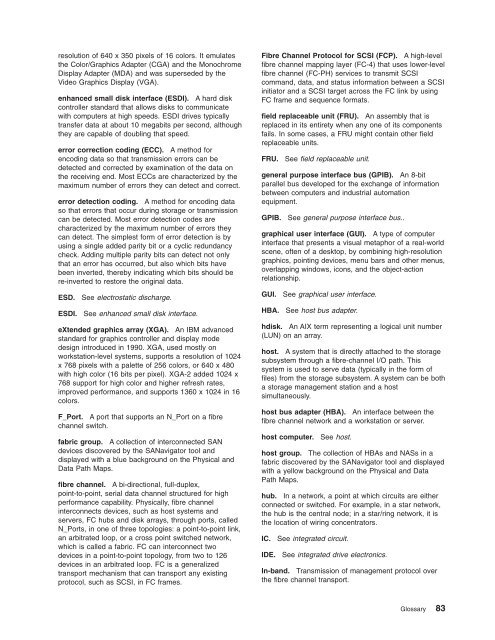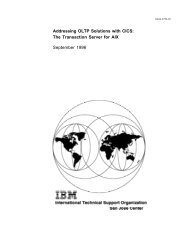install–38 - Ibm
install–38 - Ibm
install–38 - Ibm
Create successful ePaper yourself
Turn your PDF publications into a flip-book with our unique Google optimized e-Paper software.
esolution of 640 x 350 pixels of 16 colors. It emulates<br />
the Color/Graphics Adapter (CGA) and the Monochrome<br />
Display Adapter (MDA) and was superseded by the<br />
Video Graphics Display (VGA).<br />
enhanced small disk interface (ESDI). A hard disk<br />
controller standard that allows disks to communicate<br />
with computers at high speeds. ESDI drives typically<br />
transfer data at about 10 megabits per second, although<br />
they are capable of doubling that speed.<br />
error correction coding (ECC). A method for<br />
encoding data so that transmission errors can be<br />
detected and corrected by examination of the data on<br />
the receiving end. Most ECCs are characterized by the<br />
maximum number of errors they can detect and correct.<br />
error detection coding. A method for encoding data<br />
so that errors that occur during storage or transmission<br />
can be detected. Most error detection codes are<br />
characterized by the maximum number of errors they<br />
can detect. The simplest form of error detection is by<br />
using a single added parity bit or a cyclic redundancy<br />
check. Adding multiple parity bits can detect not only<br />
that an error has occurred, but also which bits have<br />
been inverted, thereby indicating which bits should be<br />
re-inverted to restore the original data.<br />
ESD. See electrostatic discharge.<br />
ESDI. See enhanced small disk interface.<br />
eXtended graphics array (XGA). An IBM advanced<br />
standard for graphics controller and display mode<br />
design introduced in 1990. XGA, used mostly on<br />
workstation-level systems, supports a resolution of 1024<br />
x 768 pixels with a palette of 256 colors, or 640 x 480<br />
with high color (16 bits per pixel). XGA-2 added 1024 x<br />
768 support for high color and higher refresh rates,<br />
improved performance, and supports 1360 x 1024 in 16<br />
colors.<br />
F_Port. A port that supports an N_Port on a fibre<br />
channel switch.<br />
fabric group. A collection of interconnected SAN<br />
devices discovered by the SANavigator tool and<br />
displayed with a blue background on the Physical and<br />
Data Path Maps.<br />
fibre channel. A bi-directional, full-duplex,<br />
point-to-point, serial data channel structured for high<br />
performance capability. Physically, fibre channel<br />
interconnects devices, such as host systems and<br />
servers, FC hubs and disk arrays, through ports, called<br />
N_Ports, in one of three topologies: a point-to-point link,<br />
an arbitrated loop, or a cross point switched network,<br />
which is called a fabric. FC can interconnect two<br />
devices in a point-to-point topology, from two to 126<br />
devices in an arbitrated loop. FC is a generalized<br />
transport mechanism that can transport any existing<br />
protocol, such as SCSI, in FC frames.<br />
Fibre Channel Protocol for SCSI (FCP). A high-level<br />
fibre channel mapping layer (FC-4) that uses lower-level<br />
fibre channel (FC-PH) services to transmit SCSI<br />
command, data, and status information between a SCSI<br />
initiator and a SCSI target across the FC link by using<br />
FC frame and sequence formats.<br />
field replaceable unit (FRU). An assembly that is<br />
replaced in its entirety when any one of its components<br />
fails. In some cases, a FRU might contain other field<br />
replaceable units.<br />
FRU. See field replaceable unit.<br />
general purpose interface bus (GPIB). An 8-bit<br />
parallel bus developed for the exchange of information<br />
between computers and industrial automation<br />
equipment.<br />
GPIB. See general purpose interface bus..<br />
graphical user interface (GUI). A type of computer<br />
interface that presents a visual metaphor of a real-world<br />
scene, often of a desktop, by combining high-resolution<br />
graphics, pointing devices, menu bars and other menus,<br />
overlapping windows, icons, and the object-action<br />
relationship.<br />
GUI. See graphical user interface.<br />
HBA. See host bus adapter.<br />
hdisk. An AIX term representing a logical unit number<br />
(LUN) on an array.<br />
host. A system that is directly attached to the storage<br />
subsystem through a fibre-channel I/O path. This<br />
system is used to serve data (typically in the form of<br />
files) from the storage subsystem. A system can be both<br />
a storage management station and a host<br />
simultaneously.<br />
host bus adapter (HBA). An interface between the<br />
fibre channel network and a workstation or server.<br />
host computer. See host.<br />
host group. The collection of HBAs and NASs in a<br />
fabric discovered by the SANavigator tool and displayed<br />
with a yellow background on the Physical and Data<br />
Path Maps.<br />
hub. In a network, a point at which circuits are either<br />
connected or switched. For example, in a star network,<br />
the hub is the central node; in a star/ring network, it is<br />
the location of wiring concentrators.<br />
IC. See integrated circuit.<br />
IDE. See integrated drive electronics.<br />
In-band. Transmission of management protocol over<br />
the fibre channel transport.<br />
Glossary 83
















